The Capitoline Hill is the smallest and most important of the seven hills of Ancient Rome. As the political and religious heart of Rome, the hill became a symbol of Rome’s reign as Caput Mundi, capital of the world.
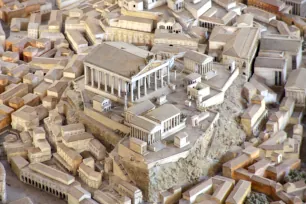
Today, the hill still symbolizes the heart of Rome, and it is the perfect starting point for a visit to the Eternal City.
Excavations of the hill have uncovered traces of a settlement that was built here in the Iron Age. The hill was an ideal site for the early settlers since it was situated right near a ford across the Tiber and its steep rocky slopes provided a natural protection against enemies.
The hill had two summits: the Arx to the north and the lower but larger Capitolium to the south. The area in between was called the Asylum. It was a place where refugees from other states could find shelter.
The Capitoline Hill in Ancient Times
Even before the Republican era, Rome’s kings built massive temples on the Capitoline Hill. They came to symbolize Rome’s position as Caput Mundi, which literally means ‘head of the world’.
Temple of Jupiter
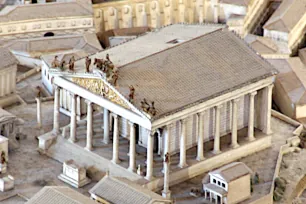
The largest and most impressive of these temples was the Temple of Jupiter Optimus Maximus Capitolinus. The gilded temple was the most important sanctuary in ancient Rome. It was built in the sixth century BC on the Capitolium summit (now the site of the Palazzo dei Conservatori) by Tarquinius Priscus, the first Etruscan king of Rome. It measured 53 by 63 meters and was dedicated to three gods: Jupiter Optimus Maximus, Juno Regina and Minerva. There was a separate cella for each god. The temple was decorated with reliefs and large terracotta statues. The statue of Jupiter was later replaced by a version in gold and ivory.
Tarpeian Rock
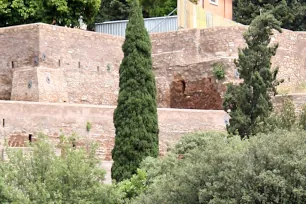
According to legend, the Tarpeian Rock, situated just south of the Temple of Jupiter, was named after a Roman woman called Tarpeia, who helped the Sabines conquer the Capitoline Hill during the reign of Romulus, the legendary founder of Rome. Tarpeia was promised jewelry for her treason, but the Sabines instead crushed here between their shields. From then on, traitors of Rome were thrown from this rock.
Temple of Juno Moneta
The north summit, the Arx, was long the site of Rome’s fortress. In 344-343 BC, a temple was built here on the order of the city’s military leader Marcus Furius Camillus. The temple was dedicated to the goddess Juno. There are several legends that explain the name Moneta, which is possibly derived from the Latin word monere, meaning warn or advise. According to one version, people heard voices from the temple that warned them of an earthquake. Another version tells us the name stems from the geese that warned Camillus when Gauls tried to capture the Capitoline Hill.
The mint of Rome stood ‘ad monetam’ – near the Temple of Juno Moneta – hence the word moneta, which gave its name to the word money.
Tabularium

The Tabularium, which housed the state archives, was built between the Temple of Jupiter and the Temple of Juno. It was a large building with several colonnaded stories that looked out over the Forum Romanum. From the Forum, you can still clearly see the remains of the lower floor of the Tabularium, now situated below the Palazzo Senatorio.
The Middle Ages
During the exile of the popes in Avignon, Rome became depopulated and the Capitoline Hill was even used as a goat pasture, which gave it the name Monte Caprino (goat mountain). By the sixteenth century, the Renaissance brought a revival of Rome’s grandeur and with it a complete redesign of its heart, the Capitoline Hill. In 1536 Michelangelo drew up plans for a new square between the two hilltops, the Piazza del Campidoglio.
The Capitoline Hill Today
Today, only traces of the ancient temples are visible. Instead, a huge nineteenth century monument built for Italy’s first king dominates the north slope.
Piazza del Campidoglio
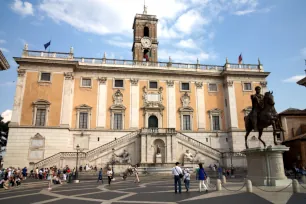
As impressive as this monument may be, the highlight of the Capitoline Hill, however, is now undoubtedly the beautiful Piazza del Campidoglio, masterfully designed by Michelangelo. It can be reached from the foot of the hill by ascending the majestic Cordonata stairs.
The square is bordered by three palazzos, all with facades designed by Michelangelo. The central one is the Palazzo Senatorio, the city hall of Rome, which was built on top of the ancient Tabularium. The other two, the Palazzo dei Conservatori and Palazzo Nuovo, are home to the Capitoline Museums.
Victor Emmanuel Monument
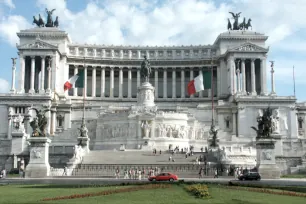
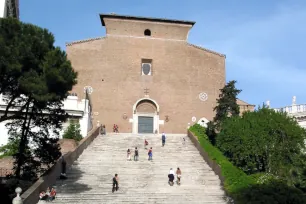
From the Piazza del Campidoglio you can walk straight to the Victor Emmanuel II Monument. This massive monument, which is also known as Il Vittoriano, was built in the early twentieth century and honors Italy’s first king. During the construction of the monument, many historic buildings on the hill were demolished.
Santa Maria in Aracoeli
Near the Piazza del Campidoglio, at the site of the ancient Temple of Juno, is the Santa Maria in Aracoeli, a church with a history that goes back to the sixth century. A large staircase with 122 (when starting on the right) to 124 (starting on the left) steps leads to the church on top of the Capitoline Hill.

